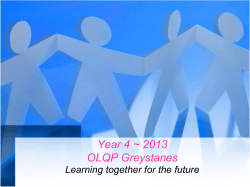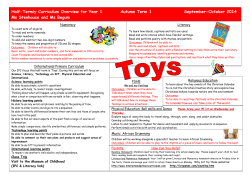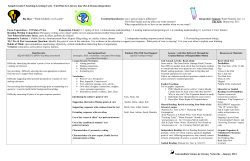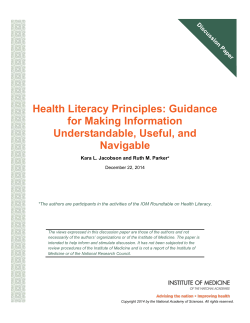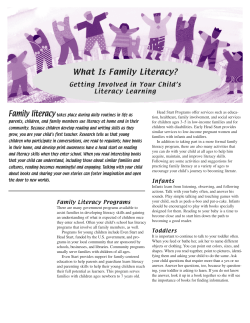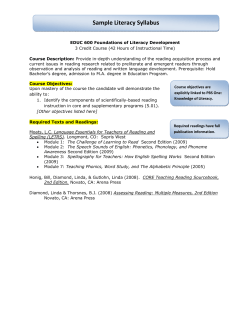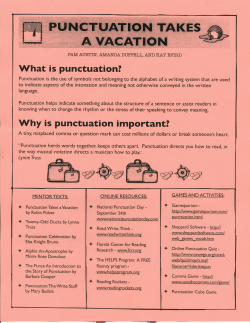
Concepts About Print Assessment Purpose:
Concepts About Print Assessment Purpose: Based on their home and early school experiences with print—bed time stories and readalouds, big book shared reading, shared writing and their very independent adventures with pretend reading and writing—young children come to kindergarten and even first grade with different understandings about the arbitrary conventions that we use to communicate meaning in print. An assessment of each child‟s level of understanding, and sometimes misunderstandings of these conventions helps teachers know what their students are attending to in print and what still needs to be learned. This knowledge enables teachers to design and focus teaching points in literacy minilessons and other classroom literacy experiences that move children forward in their understanding of how print works. Where is the front of the book? Where does the story start? Where do I start reading and where do I go after that? What is a letter? What is a word? These are important literacy understandings that can develop through guided hands-on experience with reading and writing in the literacy workshop. An assessment of emergent literacy print concepts should include: • Book orientation knowledge • Understanding of principles involving the directional arrangement of print on the page • The knowledge that print, not picture, contains the story • Understanding of important reading terminology such as word, letter, beginning of sentence, and top of page • Understanding of simple punctuation marks (Gillett and Temple, 1994, Understanding Reading Problems: Assessment and instruction. Harper Collins: NY. p. 70) Directions: In assessing concepts of print, the teacher sits with the child, one-on one, and reads an engaging early level text, asking the child to help with the reading. The book used should have distinct layout of print and illustrations, good spacing between words, multiple lines of text on each page, some basic sight words (I, me, and, is, was, etc.) and basic elements of punctuation (periods, quotation marks, question marks, exclamation points). Because the teacher reads the book to the child with the child looking on and responding to prompts, the text we are using is Honey for Baby Bear at a level F. This text has varied and sophisticated text layout and punctuation. (Other sample texts, levels C-F might include: Where is Hannah? Ben’s Teddy Bear, A Friend for Little White Rabbit, Nick’s Glasses, Dan, the Flying Man, Going to Lucy’s House). The teacher should be very familiar with the text (story, layout and features, punctuation, etc.) before reading with the child. Have ready two brightly colored index cards, a pencil and the record sheet. This assessment incorporates prompts that help the teacher observe a student‟s behaviors in response to the prompts and note these on the record sheet. (While working with the child, you will want to make small tick marks to note correct responses and keep moving, but later note the child‟s specific behaviors and responses.) Based upon the research of Clay, M. M. (2000). Concepts About Print: What have children learned about printed language? Portsmouth, NH: Heinemann. ©TCRWP 2006-07 Do not duplicate without permission. Student‟s Name: _________________________ Date:___________________ Teacher/Recorder:________________________ Grade/Class:_____________ Concepts of Print Choose a Level C-F book for the administration of this assessment. It should have distinct layout of print and illustrations, good spacing of words and multiple lines of text. Begin by telling the child, “I‟m going to read you this story and I want you to help me. It is called .” 1. Orientation or layout of text/ Front of book: Hand the child the book, holding it vertically so that the spine faces the child. Ask: • “Where is the front of the book?” • “Where is the back of the book?” • “Open the book to where the story begins.” Child can open the book to title page or first page of story. Score one point for each 2. Print, not pictures, carries the message: With the book open to page 1, ask the child: • “Show me the picture.” Describe and discuss details of the picture. • “Show me the words.” Only score one point if both are correct 3. Direction of print: On the same page ask: • “Show me where to start reading.” If child’s response is vague, prompt, Where exactly?” Show me with your finger.” • Point to the first word, read it and ask: “Where do I read after this?” Only score one point if both are correct 4. Page sequencing: Point to the last word on the left page and ask: • “Where do I read after this? Score one point 5. Difference between letter and word: Give the child the two strips of paper. Demonstrate how they slide together and apart on a page in the book. On the same page ask: • “Show me one letter.” • “Show me one word.” • “Show me the first letter in a word.” • “Show me the last letter in a word.” Score one point for each 6. Return Sweep: Turn to a page with at least 2 lines of text. Read the top line and keeping your finger on the last word ask: • “Where do I read after this?” Score one point 7. One-to-One Correspondence: Point to the first word on a new page and before reading, ask the child: • “Point to each word as I read this line.” Does the child follow and match text as you read? Score one point 8. Punctuation: Point to the period, tracing it with your pencil and ask: • “Do you know what this is?” If so, ask: “What is this for?” Score one point __/13 TOTAL For benchmark scoring rubrics please see the Benchmarks for Primary Assessments document. Based on Clay, M.M. (2000). Concepts About Print: What have children learned about printed language? Heinemann: N.Z. ECLAS-II. Literacy Development Checklist. (2003). CTB/McGraw-Hill. ©TCRWP Concepts about Print—Implications for Instruction: Marie Clay calls concepts about print “the rules of the road,” and writes, “Teachers must teach so that all children become knowledgeable about these essential concepts so they open doors to literacy.” She explains that teachers who have an understanding of what aspects of print their students are attending to can introduce students early on to print conventions through experiences in both reading and writing—especially through focused instruction in the first six months of school (Clay, 2000, pp. 24-25). Reading and writing are reciprocal literacy activities, especially in the early years; that is, they both promote student literacy learning and provide the experiences that children need to gain knowledge and use of „the rules of the road.‟ Through explicit teacher modeling as well as lots of guided practice and experience, students take on the concepts, and use them until the concepts become more automatic. Based on teacher assessment, this literacy learning should and could be part of whole group, small group and one-on-one (conferring) learning contexts—from reading the morning meeting chart to writing a morning message together as part of an interactive writing experience, from shared reading of a big book with a focus on pointing to each word as we read and moving across the page from left to right, to writers‟ workshop mini-lessons where a teacher models where to start writing on the page or how to leave space between words so that readers can reread them. Most importantly, because children have such varied and broad experiences with print when they first come to school, this assessment, together with ongoing running records and observation of students‟ writing, will help teachers to pull together small strategy groups for guided instruction and practice—whether it be a group of children who are ready to attend to punctuation in their own writing or a child who still needs support in pointing to words as s/he reads across a single line of print on a level A text. Finally, while print layout, directionality, spacing and the stop and go marks of punctuation determine the “rules of the road,” the major entry into discovering how print works is building an understanding of how letters in print come together to represent sounds in words. Early letter and word study can begin with very important words, the children‟s names: How many letters are in your name? What is the first letter? What sound does that letter make or what is the first sound you hear in your name? How many claps (syllables) are in your name? Is it a long name or a short name? As a strategy to building classroom community and literacy the children can have opportunities to play with their names, to sort names in their classroom by the number of letters, by the number of claps, by first letter, and to chant their names from a chart or word wall. Children‟s names go up on the word wall first. As the word wall expands to include little words the children see in books and want to write in their stories, the children learn about the concept of word—that words have first and last letters and sounds, that they are separated by spaces on the page and that the left to right directionality holds true in reading and writing words as it does in moving across a line of print: letters represent the sounds in words in left to right sequence. As young children chant words from the word wall, find them in a big book, or stretch them out to write during writer‟s workshop and then edit for accuracy of word wall words, they also learn that no matter the font or page layout, the sequence of letters for each word will always be the same. Based on Clay, M.M. (2000). Concepts About Print: What have children learned about printed language? Heinemann: N.Z. ECLAS-II. Literacy Development Checklist. (2003). CTB/McGraw-Hill. ©TCRWP 2006-07 Do not duplicate without permission.
© Copyright 2025


